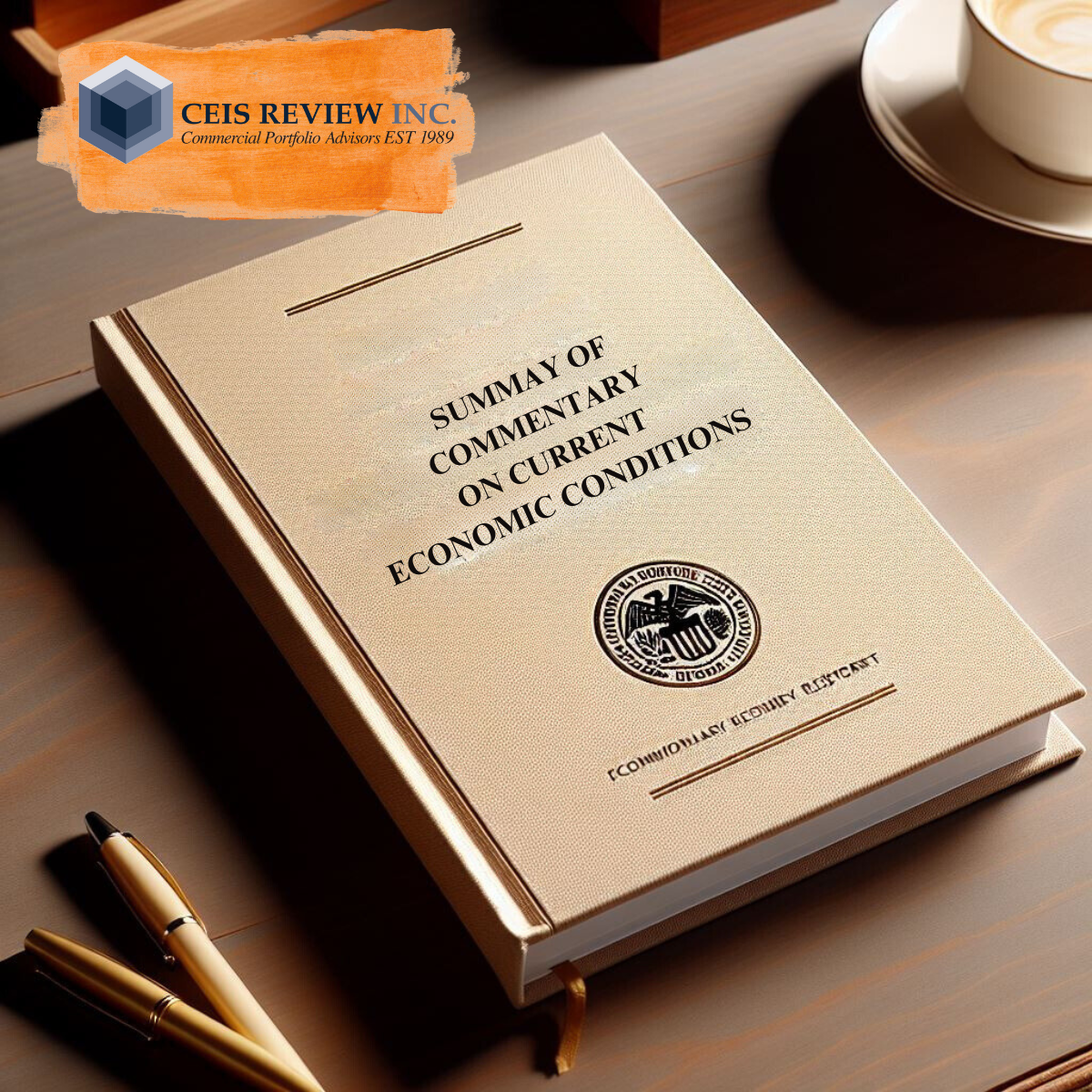Results of the most recent Federal Reserve Senior Loan Officer Opinion Survey (“SLOOS”) – The CEIS Quarterly Newsletter – Volume 5, Issue 3
Select here: The CEIS Review Quarterly – Volume 5, Issue 3
New York, August 15, 2019 – CEIS Review Inc. is a Commercial Loan Portfolio Consulting firm serving the needs of Commercial Lending Institutions. In this issue of our newsletter, we discuss the results of the most recent Federal Reserve Senior Loan Officer Opinion Survey (“SLOOS”) which covers insights on Bank’s lending standards and practices, and how they have changed over time, then we take a look the elements and importance of having an appropriate Credit Risk Rating System at your Institution.
ON MY MIND … CEIS’ President and CEO, Joseph Hill, share his thoughts
 The FRB released their July 2019 Senior Loan Officers Opinion Survey on Lending Practices that included 74 domestic Banks and 22 Foreign Branch Offices or Agencies. Briefly, the report noted that “… standards basically unchanged on commercial and industrial (C&I) loans to large and middle-market firms, while standards eased for such loans to small firms. Most terms were reportedly eased on C&I loans across firm size categories. In addition, banks reportedly tightened standards over the past three months across all three major commercial real estate (CRE) loan categories—construction and land development loans, nonfarm nonresidential loans, and multifamily loans.”
The FRB released their July 2019 Senior Loan Officers Opinion Survey on Lending Practices that included 74 domestic Banks and 22 Foreign Branch Offices or Agencies. Briefly, the report noted that “… standards basically unchanged on commercial and industrial (C&I) loans to large and middle-market firms, while standards eased for such loans to small firms. Most terms were reportedly eased on C&I loans across firm size categories. In addition, banks reportedly tightened standards over the past three months across all three major commercial real estate (CRE) loan categories—construction and land development loans, nonfarm nonresidential loans, and multifamily loans.”
Also from the noted report:
“Banks reported that, on net, their current levels of lending standards for all categories of C&I loans are at the easier ends of their respective ranges since 2005. In particular, significant net shares of banks reported that their lending standards for syndicated C&I loans to in- vestment-grade firms and non-syndicated C&I loans to large and middle-market firms are currently easier than the respective midpoints of the historical ranges.
Meanwhile, moderate net fractions of banks reported that their current standards for other types of C&I loans are at the easier ends of their historical ranges. Banks’ responses regarding the current level of lending standards for most C&I loan categories were broadly in line with their responses in the July 2018 survey.
Among foreign banks, significant and moderate net fractions reported that their current levels of lending standards for investment-grade and below-investment-grade syndicated loans, respectively, are at the easier ends of their historical ranges. However, a significant net share of foreign banks reported that their level of standards for loans to small firms is at the tighter end of the range between 2005 and the present.
For CRE loans, banks reported that the current levels of their standards for all major categories of these loans are at the relatively tighter ends of the ranges that have prevailed since 2005 on balance. Significant net percentages of domestic banks reported that current levels of standards are tighter than the respective midpoints of the historical ranges on loans for construction and land development purposes and on nonfarm nonresidential loans. A moderate net percentage of banks reported that the lending standards are tighter than the midpoint of the historical range on loans secured by multifamily residential properties. Banks’ reported levels of CRE lending standards were similar to those reported in the July 2018 survey across CRE loan categories, except for nonfarm nonresidential loans, for which lending standards are reportedly tighter.”
Joseph Hill – CEO & President of CEIS
Reference:
1. Board of Governors of the Federal Reserve System. July 2019 Senior Loan Officer Opinion Survey on Bank Lending Practices. Washington, D.C.: Federal Reserve, 2019.
Credit Risk Rating System – A Dynamic Management Tool
What is a credit risk rating system?
A credit risk rating system provides the means by which a financial institution can grade each transaction in the commercial loan portfolio by the level of risk it contains. While this paper primarily focuses on credit risk arising out of loan transactions, banks may also incur contingent and direct credit risk by issuing L/Cs, and by entering into derivative and/or foreign exchange transactions, and cash management services. Such risks should not be overlooked when implementing a credit risk rating system.
What are the regulatory requirements?
For banks not in the “large bank” category, regulators do not impose specific requirements for rating commercial credit transactions. The regulators do require that banks assign categories of Special Mention, Substandard, Doubtful and Loss to transactions where appropriate (1), (2). It is the universal practice of banks to incorporate these categories and definitions into a credit risk rating system. In doing so, banks usually also incorporate the regulatory definitions for these categories. There is no obligation to use those definitions but if a bank opts to use different criteria, then it must indicate what the regulatory equivalent is to each of these criticized grades.
Why do we need a credit risk rating system?
The bank’s credit policy, as approved by the board of directors, provides direction as to the bank’s appetite for credit risk. The bank needs management tools that will permit it to ensure that it is in compliance with bank policy. The credit risk rating system provides a means of both documenting the bank’s policy and measuring and monitoring compliance with that policy on an ongoing basis. Most banks also use the data held in the credit risk rating system as a core input for calculating the loan loss reserves. There is no standard risk rating model. Each bank should use a system designed to meet its needs. It is in recognition of this that the regulators are not more specific in their requirements. The most important consideration is the level of detail which is outlined in the model. The model should have a sufficient number of grades to provide useful information while not being so detailed that it becomes administratively burdensome. The number of grade levels will primarily depend on the breadth of the spectrum of risk embedded in the portfolio, and where within that range it lies both in dollar terms and in terms of number of transactions and/or clients.
Many banks adopt a 9-grade scale. The top two grades are usually re- served for cash collateralized transactions and claims on the Federal Government, and transactions secured by marketable financial instruments, Federally guaranteed portions of SBA loans, and loans to investment grade entities etc, respectively. Grades 3-5 will usually house the bulk of the bank’s portfolio, split into low, medium and high risk transactions. Finally, in grades 6-9 the bank will incorporate the 4 criticized categories as de- fined by the regulators.
A bank may employ a Watch List regime as the means of enhanced monitoring of transactions. The Watch category is sometimes included as a separate grade in the system. Some banks append a “W” or other modifi- er to an existing grade. As a further refinement a bank may split the rating on loans where part is secured or guaranteed and part is not, for example, where loans are partially cash collateralized or partially guaranteed (as in SBA loans). Some banks distinguish between the borrower risk and trans- action risk by rating them separately. In assigning credit ratings, banks should take into account business groups, affiliates and guarantors. Especially where two borrowers depend on the same source of cash flow for debt service, it makes sense for those borrowers to share the same rating unless there are cogent reasons for rating them differently.
Loan grades should be clearly spelled out in the bank’s manuals. Where possible, specific objective criteria, such as ratios, collateral, etcetera should be incorporated. Banks may usually adopt separate definitions for different types of businesses at each grade. Some banks use a matrix approach, where the different risk criteria (DSCR, LTV, quality of management, etc.) are separately scored. The rating is obtained as an average of those scores, weighted according to the importance the bank assigns to each of the criteria. Such banks adopt several matrices to cover different kinds of loan product. These systems help bring consistency to the rating system’s application. It is, however, recommended that banks make it possible to override such systems should the need arise, since no system can cater to all possible combinations of circumstances.
Uses of the credit risk rating system.
The system’s primary use is to measure and manage the risk contained in individual credit transactions. When all transactions have been rated, the bank can then consolidate the ratings and obtain a risk profile of the port- folio as a whole. Updating the profile periodically, the bank can analyze change in each risk category over time, and, through this migration analysis, identify the trend in risk in different parts of the portfolio as a whole. Updating the profile periodically, the bank can analyze change in each risk category over time, and, through this migration analysis, identify the trend in risk in different parts of the portfolio. Using the system together with loan types, industry, geographical data and other information, management may be able to isolate trends affecting more specific areas of the portfolio.
While trends may reflect changes in the economic environment, they can also vary with changes in bank lending strategy. Changes can also occur for less obvious reasons, such as the not necessarily intentional tendency towards higher risk when lenders chase yield in an overly liquid market. Analysis of changes in the portfolio risk profile helps management to identify and understand these trends. Rating systems can also be used in a proactive fashion to project the effect on the bank’s portfolio risk profile of purchasing a portfolio of loans or incorporating a large new lending relationship.
System data has other uses outside portfolio risk management. Banks use credit risk rating system data to calculate reserves. While a detailed discussion of FAS5 is outside the scope of this paper, it will be evident that the bank’s ability to segment its portfolio according to risk plays an important part in making reserve calculations. The bank can also use the rating system as an input in the process of pricing transactions. The bank can calculate the weighted average pricing for each grade, and can then use that as a reference point for pricing future transactions that fall into that risk grade. Such analysis can, of course, incorporate other portfolio data (loan types etc). The bank can thus make sure that pricing is consistent and that the bank is receiving an adequate return on the risk being incurred. Yet more uses can be found for the system and its data, depending on the needs of the bank concerned, such as helping to determine at what level in the bank transactions may be approved, and determining loan conditions, such as amount, repayment terms, frequency and quality of required financial information, frequency of review and covenant requirements.
Procedures
While each bank has its own process for assigning credit ratings, it is common for ratings to be assigned before or during the decision making process as to whether to lend. If the bank does otherwise, much of the utility of the system will be lost. In some banks, the credit department rates the loans to ensure independence of the processes. While the purpose is a valid one, it lessens the sense of ownership that the account executive has for the loan and relationship. It is perhaps preferable to have both credit department and account executive assign ratings to the loan, with the final decision on the rating being left to the approving authority.
For the system to retain its value as a management tool, credit ratings must be reassessed from time to time and, where necessary, updated. Most banks reassess ratings at least once a year. The process will normally include a re-examination of all of the criteria the bank used in the original assignment of the ratings. Some banks subject those transactions with higher risk volatility to more frequent reassessment. Normally, an upgrade in rating will require an approval at a level at least equal to that at which the rating was originally assigned. Decisions to downgrade transactions within the Pass segment of the portfolio are sometimes permitted at a lower level of seniority. On occasion it may be appropriate to make a change to a rating at a time other than when the periodic reassessment is due. In such cases it is recommended that care be taken to document on the credit file both the decision and the reasons for taking it.
Loan Review
It is essential that ratings under the credit risk rating system be assigned consistently and in a timely fashion. To the extent that they are not, the utility of the system can be greatly diminished. A primary purpose of Loan Review is to ensure that the bank is properly measuring, managing and reporting the risk embedded in the loan portfolio. An objective of the Loan Review function is to validate the ratings assigned. Loan Review must determine whether transactions are being rated in accordance with bank policy and procedures.
The party performing the loan review must enjoy a high level of credibility based on technical know-how and experience. While it is beyond the scope of this paper to present the arguments in favor of independent loan review, the advantages of engaging, experienced and skilled personnel will be self evident: it means access to a team fully versed in best practices and with knowledge of the expectations of regulators based on observation at a large number of small and mid-sized financial institutions.
Some Pitfalls
If a credit risk rating system is properly designed and implemented, the bank will reach a point where considerable reliance is placed on the system in making credit, portfolio management and related business decisions. There is a natural tendency among lenders to lean to the upside in assigning ratings, while the credit department may lean in the other direction. Both tendencies should be strongly resisted, since they can distort the basic data on which the bank depends in making such decisions.
On the one hand, it may lead to insufficient return for the risk. On the other, an overly conservative rating may lead to the bank losing business by pricing itself out of the market. Grading inaccuracies may also occur where provisional grades are assigned, as in the case of newly acquired loan portfolios. Assigning a provisional grade may be unavoidable. In such cases it is strongly recommended that the bank prioritize rating transactions in accordance with the bank’s system in order to restore the system’s integrity.
If a bank’s system has an appropriate number of grade levels, the problem can arise where, in practice, 70-80% of the bank’s business gets assigned to a single grade. This kind of concentration reduces the usefulness of the system since analysis of migration no longer yields usable information. Assuming there is some level of diversification in the portfolio, when this happens, it is time to review and adjust the grade definitions. Merely having the requisite number of grades at the bank’s disposal is not sufficient if the grading system does not give rise to some segmentation of the portfolio.
Conclusion
Today’s regulator is concerned about banks’ ability to manage the risks that are inherent in the banking business. Credit risk is one of those risks. The most widely used tool to manage it is the credit risk rating system.
While regulators leave banks considerable latitude to determine their own type of credit risk management system, the bank that does not make effective use of one (for example, a bank which employs a single pass grade) will find it difficult to persuade its regulator as to the adequacy of its analysis. On the positive side, adoption of an effective credit risk rating system opens up significant opportunities to improve credit, portfolio management, and related decision-making with consequent improvements in safety, soundness, and profitability.
References:
- Federal Reserve – Commercial Bank Examination Manual (http:// federalreserve.gov/boarddocs/supmanual/cbem/cbem.pdf) 2040.1 – Credit Grading Systems
- OCC – “Rating Credit Risk” is a separate OCC Controller’s Handbook Latest version was issued in April 2001 (http://www.occ.gov/pub- lications/publications-by-type/comptrollers-handbook/rcr.pdf )







